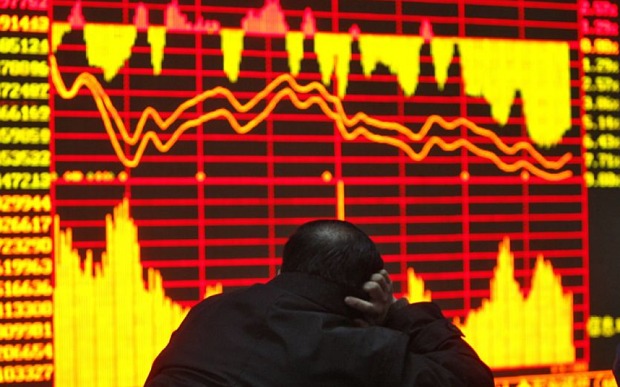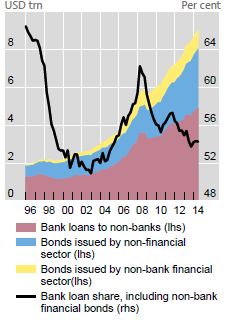Liquidity drought could spark market massacre, warns IIF
Evaporating liquidity and larger US curiosity rates will result in enormous marketplace swings with perhaps catastrophic repercussions, Institute of Global Finance warns &#thirteen  
 
 &#thirteen 
 Photograph: Reuters &#thirteen &#thirteen

 
 &#thirteen 
 Photograph: Reuters &#thirteen &#thirteen
Buyers confront a “painful” adjustment in a planet of evaporating liquidity and higher US curiosity prices that will bring about large marketplace swings with potentially catastrophic implications, the Institute of Intercontinental Finance has warned.
Timothy Adams, the main govt of the IIF, which represents the world’s largest financial institutions, explained liquidity as the “top issue” at high level conferences of central bankers, chief executives and other financial establishments.
He warned that the raft of regulation released in the wake of the 2008 disaster could potentially trigger market gyrations bigger than last October’s “flash crash” in US Treasuries.
Although Mr Adams supports harder guidelines that have made the banking companies far more resilient, he said a intricate web of regulatory reform may possibly have remaining financial institutions much less in a position to reply to the following crisis.
“There’s just significantly less potential for creating marketplaces,” he explained. “Officials will say: we assume some volatility and this was component of this broader plan of regulatory reform. But for the private sector there is this situation of: is the total influence of all of these different regulatory adjustments probably to create results bigger than each and every specific regulatory reform and its repercussions?
“The cumulative unintended could finish up getting much larger than the a single-off supposed – we just do not know.”

Mr Adams said a complicated internet of regulatory reform might have left banking institutions less capable to answer to the up coming crisis (Picture: AFP)
- Far more: Liquidity crisis could spark the following economic crash
- Worldwide finance faces $ nine trillion stress take a look at as dollar soars
Market liquidity, or the relieve with which an investor can speedily purchase or offer a protection with out relocating its value, has developed because the financial disaster. Investment banking companies, which usually supported liquidity in moments of pressure, have been shrinking their actions.
Corporate bond inventories have fallen by 75pc in the US and 50pc in Europe since 2007, according to IIF knowledge. Whilst much of this has been pushed by financial institutions unwinding big credit books, regulation has also discouraged them from keeping huge portions of bonds that could assist cushion violent swings in charges.
Mr Adams stated a “dramatic revolution” of the players and pitfalls of marketplace creating had also pushed danger “out into the shadows” of non-bank lending.
“We’ve rewired and re-engineered the international financial regulatory technique and as a result we’re having profound impacts on institutional arrangements. At the identical time we’ve had this fast modify in benchmark charges these kinds of as a 50pc fall in the value of oil, a fast change in the dollar and other exchange costs and one more drop in commodity charges,” he explained.
“Once you bring the speedy alter in major benchmark charges and a change in the architecture of the global monetary system together, you could stop up with outcomes that are rather painful, and surely unknowable.”
Mr Adams warned that the US Federal Reserve’s initial curiosity rate increase in nearly a decade would also trigger disruption, and that the “the most clear and telegraphed transfer in financial history” was unlikely to avert some dollar denominated money owed from “blowing up” in rising marketplaces.
“I even now have scars from 1994 right after the economic downturn and the Fed 1st hiked. So it will be the most clear and telegraphed move in monetary historical past, but as soon as you commence that cycle, it will certainly be disruptive.”
Mr Adams mentioned building economies which had developed up big money owed were most at danger of funds flight. “Emerging marketplaces that have very poor fundamentals, very poor coverage regimes and have more than borrowed could see quite volatile instances going ahead. Now is the time to set in location great regimes and buffers against likely downside dangers due to the fact the organization cycle has not absent away.
“I fret due to the fact you have a good deal of nations around the world in which you have noticed a incredible increase in corporate greenback denominated personal debt – so you’ve received a foreign exchange danger, but you have also acquired a credit chance. The issue is: is some of that credit card debt heading to blow up, and then is there a sovereign harmony sheet guiding it? Individuals nations around the world are likely to feel strained.”

Overall US dollar personal debt outdoors US (still left)
Credit score to non-lender debtors outside the house the United States has developed to $ 9 trillion, from $ six trillion considering that the economic crisis, in accordance to the Bank for Intercontinental Settlements (BIS) . IIF knowledge present emerging market place greenback denominated debt has more than doubled to $ two.6 trillion in a decade.
The BIS measure, which contains lending through banking institutions registered in other jurisdictions, exhibits the figure is nearer to $ 4.five trillion these days , leaving the entire world much more delicate to alterations in fascination rates by the Federal Reserve.
Meanwhile, worldwide bond markets have developed from $ 30 trillion in 2000 to almost $ ninety trillion. Even so, the IIF has highlighted that buying and selling volumes in US bond markets have fallen by 20pc when compared with 2005.
Jamie Dimon, the main govt of JP Morgan, warned in April that more durable lender regulation intended the following monetary disaster would set off a lot more market volatility, as cash policies manufactured it also high priced for financial institutions keep massive shares of securities to trade.
He stated discord in the US Treasury and forex marketplaces had been a “warning shot throughout the bow”, anticipating the turbulence throughout the following crash.
Mr Adams agreed that the sharp swing observed in US Treasuries last Oct was likely to be recurring.
“Personally I’m much more focussed on the foreseeable future simply because a whole lot of these regulatory alterations have not nevertheless been totally carried out, and some of them are nonetheless being debated – capital expenses with respect to devices on the buying and selling e-book and the implementation of TLAC [complete loss-absorbing capability].

The “flash crash” in US Treasuries, captured by the International Monetary Fund. Jamie Dimon, the chief government of JP Morgan, explained the transfer of 37 foundation factors on October fifteen was “an function that is meant to come about only when in every single 3 billion a long time or so” (Source: IMF)
“There are some concerns that a couple of activities that we have seen is purpose of these regulatory modifications, that may or may possibly not be the situation, but seeing above the next calendar year or two, and will we have equivalent events [to the flash crash] – if not larger – that could then warrant more investigation and searching at the cumulative influence of these regulatory adjustments.
Dame Clara Furse, an external member of the monetary coverage committee, which is in charge of economic security, explained in February that liquidity in some markets experienced “become far more fragile” , which could consequence in “unforeseen effects” for markets.
The Financial institution of England, led by Governor Mark Carney, will operate with industry contributors and sector bodies this kind of as the IIF to evaluate no matter whether asset managers could cope with a rapid alter in market conditions .
Mr Adams said policymakers ended up now experiencing the challenge of navigating the new economic get.
“I grew up in the 1970s and 80s when it was all about attempting to get inflation down, you had a steep generate curve and it just feels like we’re in a very different and overseas place,” he stated. “At the same time we’re re-engineering the monetary architecture, so we just really don’t know what the linkages are.
“As you turn the dials of plan, you really do not know how a lot to flip it in purchase to get a specified sum of effect, so you’re producing it up as you go alongside, and that’s a little bit horrifying if you are in a position of accountability.
In conditions of volatility, officers will say they want a two-way industry. They argue that there is been too much complacency. But it’s like stating, I want to get on a rollercoaster since I want to have exciting. Well you’d greater make confident you’re all set and you’re strapped in and this is a rollercoaster that you comprehend.”
